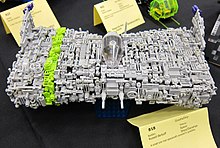Greeble


A greeble (/ˈɡriːbliː/ GREE-blee[citation needed]), or "nurnies", is a part harvested from plastic modeling kits to be applied to an original model as a detail element. The practice of using parts in this manner is called "kitbashing".[1]
Etymology
The term "greeblies" was first used by effects artists at Industrial Light & Magic in the 1970s to refer to small details added to models. According to model designer and fabricator Adam Savage, George Lucas, Industrial Light & Magic's founder, coined the term "greeblies".[2] Ron Thornton is widely believed to have coined the term "nurnies" referring to CGI technical detail that his company Foundation Imaging produced for the Babylon 5 series,[1] while the model-making team of 2001: A Space Odyssey referred to them as "wiggets".[3]
See also

- Bump mapping
- Diapering
- Fractal art
- Horror vacui
- Kitbashing
References
- ^ a b Fronczek, Steve (January 20, 2008). "Interview: Charles Adams". Future-past.com. Archived from the original on September 9, 2009. Retrieved September 8, 2022.
- ^ Fameli, Joey (6 September 2018). "Adam Savage's One Day Builds: Kit-Bashing and Scratch-Building!" (video). YouTube. Adam Savage's Tested. Retrieved 9 December 2022.
- ^ "What Are Nurnies". LEde Designs.
One FX group in the UK who built the space ship for '2001: A Space Odyssey' called them wiggets.
External links
- Staffan Norling's comments about greebling
- Starship Modeler: a resource for science fiction modeling
- buzzGreeble for modo
- Greeble plugin for 3D Studio Max
- Greeble plugin for Realsoft 3D
- Greeble plugin for trueSpace
- Greeble plugin for LightWave
- Greeble script for Blender
- Greeble script for Autodesk Maya
- Greeble script for Cinema 4D
- Sample of Sci-Fi Greebles 3D Assets










